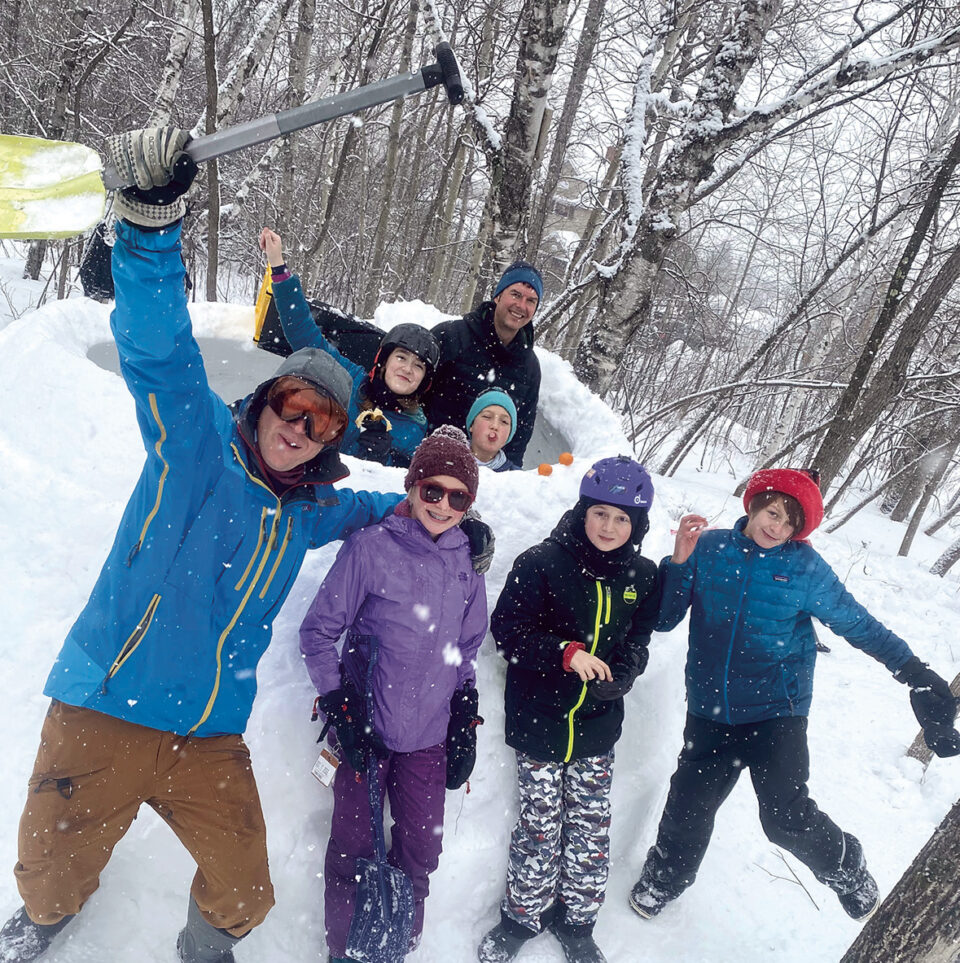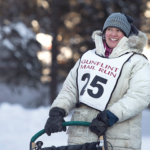Igloos are the ultimate tool for teaching kids about winter. The raw materials are free (if you’ve got snow), the collaborative building process teaches teamwork, and the resulting shelter taps into our primitive survival instincts. And who doesn’t like building huge forts?
Last winter my 3-year-old daughter started an outdoor preschool in Duluth. Following the preschool’s lead, I knew we would need to embrace winter, no matter what it threw at us. At the same time, I discovered a tool sold by skipulk.com (a Minnesota company) called the “ICEBOX.” This tool forms perfect igloo blocks, and has a pivot pole with length adjustments that makes it possible to bring the igloo inward at its peak, creating a circular dome roof. The preschool director and I split the cost, and the tool arrived in early December. What followed was 140 inches of epic winter—Duluth’s all-time record snowfall. Talk about prophetic!
Here’s what we learned about harnessing the snow to make romantic backyard retreats when winter is beating down on you.
Igloo Qualities
Igloos take time, physical labor, and skill to build. But the return on your sweat investment can last for months. That was the case at Wind Ridge Schoolhouse, where a menagerie of preschoolers, neighborhood schoolchildren and a few lucky adults all built an igloo in one long day, the week before Christmas 2022. The elegant structure stood like a rock until April, providing shelter and strength to the hardy preschoolers.

Laura Whittaker, founder and teacher at Wind Ridge, recounts the igloo’s importance to her program. “It’s been so good to have a shelter that feels really nature-based. One of the things that we do in nature preschool is focus on nature immersion, and in northern climates there are times when the wind is such a huge factor. So having a space for the children to feel tucked in and cozy, yet still be connected and reliant on nature, was so powerful.”
Grant Schnell, owner of skipulk.com with his wife Ashley, says that humans are all the heat an igloo needs, thanks to snow’s insulating properties. “Let’s say you’re doing some story-telling in an igloo. You stack five or six people in there, and it can warm up significantly,” explains Schnell. He’s also a big fan of the serenity igloos provide. “It’s unbelievable how quiet they are inside,” notes Schnell.
Enter an igloo, and you are immersing yourself in a micro-environment protected from cold, wind, and sound.
Using the ICEBOX
Schnell got introduced to the ICEBOX tool by “Igloo Ed” a number of years ago. “He designed the tool—it was his passion. It just grew from there,” recounts Schnell. Skipulk.com distributes the tool today.
Schnell built six igloos himself last winter, including one with his mentor, Igloo Ed. “The ICEBOX is a fun tool, but it definitely requires some learning,” Schnell specifies.
So how does it work? First, build a very wide, flat, elevated platform. Kids are the perfect helpers—the more stompers the better. Get the base level, then insert the ICEBOX stake into the center point of where you want your igloo. Assemble and adjust the length of the included pole to your preferred igloo diameter. If you want an 8-foot igloo, your pole should be extended to 4 feet. The ICEBOX block mold attaches to the end of the pole.
Next, gather loose snow at your feet, and pack some at a slant part way up the ICEBOX, to build a short ramp. After the ramp, fill the mold full for the rest of the igloo blocks. Once you’ve packed each block, use the ICEBOX’s clever release lever to expand its four sides—thereby leaving the block to stand on its own. Carefully lift the tool over the block, then move it further along the wall, adding block after block, layer after layer. Adjust the pole length for the next layer each time the ramp area is passed. You will eventually create a stable and solid arch.

Snow is packed into the tool with a push to make the snow sinter and bond to the previous block, and the wall below. The best consistency, according to Schnell, is “fluffy, but you can still make a snowball out of it.”
If you get lucky, you’ll get “hero snow” on your first attempt.
Pro Tips
Sleds and shovels are key to a good igloo-making experience. A deep sled allows you to transport snow—you’re going to need a lot of it. Another useful tool is a smaller “avalanche shovel,” such as the MSR Operator or Responder models. These telescoping shovels are made of lightweight aluminum and are kid friendly. Adults can operate them with one hand, which can really help when packing the ICEBOX.
Another essential tip from Schnell—“Don’t hit the ICEBOX with your shovel.” The snow bonds to itself when you pack it into the mold with your hands. Hitting the box as you’re creating a block will cause the amassed snow to fracture. As soon as the block cracks, it really can’t be repaired.
If you’re finding the process slow-going, and can’t complete the igloo in one work shift, don’t fret. After you’ve built up a few layers, you can easily tarp off the roof, making the shelter temporarily functional for snow and wind protection (albeit with lower sound and warmth insulation than a finished igloo).
Once your igloo is complete, it’s time to go have fun. Snow can be easily decorated with food coloring and a spray bottle. Let the kids get creative!
Finally, after your igloo has had a night to freeze solid, you can even stand on top of it. The round dome shape provides extra strength and support.
Don’t be Square
Igloos have many special properties. They’re simple, quiet, and relaxing. Perhaps all of these elements owe themselves to the structure’s round, arched shape. We harken back to Inuit igloos, Ojibwe wigwams, and Dakota teepees when we enter a round shelter. This is a needed antidote to our square society. As Schnell points out, “We’re used to boxes. We put everything in boxes. But the earth is round.”

Nobody does better in igloos than kids. For Whittaker, “The cutest memory I have from last winter is almost every day we’d gather in the Wild Wood igloo and have teatime. The 3-6-year-olds would sit along the perimeter of the circle, and we’d pour the tea, which of course was hot, so the cups melted little cup holders in the igloo floor. We’d pass the tea out, and the preschoolers would smell the warm aroma, and we’d all tell an ‘and-then’ story, where the story circles around the igloo. It’s really living in the round in there.”
Could there possibly be a better testament to igloo life? Go make your own backyard igloo, or bring the ICEBOX to a frozen Boundary Waters lake, and let the stories begin.





